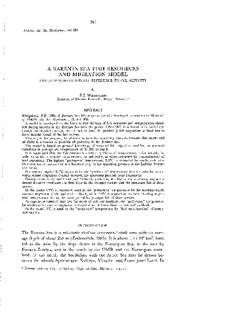| dc.description.abstract | A model is developed on the basis of distributions of fish resources and temperatures observed
during surveys in the Barents Sea over the period 1983-1987. It is found to be useful (although
not detailed enough, due to lack of data) for predicting fish migrations at least two to
three months ahead of the last survey.
This might, for instance, be of great interest for predicting contacts between fish stocks and
oil slicks in scenarios of possible oil pollution in the Barents Sea.
The model is based on general knowledge of seasonal fish migration modified by seasonal
variations in average sea temperature at 50-200 m depth.
It is postulated that the fish migrate towards a "preference" temperature, either directly, in
order to satisfy metabolic requirements, or indirectly, as when attracted by concentrations of
food organisms. The highest "preference" temperature, 5.5°C, is estimated for southwards winter
migration of mature cod and haddock (e.g. to the spawning grounds in the Lofoten-Vesterålen area).
For mature capelin 3.5°C seems to be the "preference" temperature in the model for southwards
winter migration (mainly towards the spawning grounds near Finnmark).
During summer the older cod and haddock, preferring the higher temperatures, migrate a
shorter distance northwards to feed than do the younger mature and the immature fish of these
species.
In the model 5.5°C is, therefore, used as the "preference" temperature for the northeastwards
summer migration of old cod and haddock, while 3.0°C is applied as the best "feeding migration"
temperature during the same period for younger fish of these species.
As capelin in summer may live far north of cod and haddock, the "preference" temperature
for northwards summer migration is expected to be lower than for cod and haddock.
In the model 1°C is used as the "preference" temperature for "feeding migration" of immature
capelin. | en |
